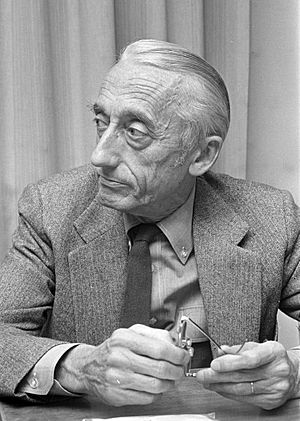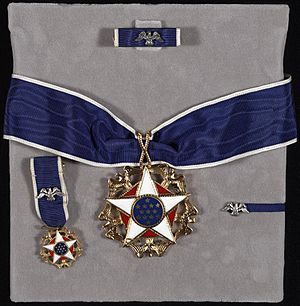Jacques Cousteau facts for kids
Quick facts for kids
Jacques-Yves Cousteau
|
|
|---|---|

Jacques-Yves Cousteau in 1972
|
|
| Born | June 11, 1910 |
| Died | June 25, 1997 (aged 87) Paris, France
|
| Cause of death | Heart attack |
| Resting place | Saint-André-de-Cubzac, France |
| Nationality | French |
| Occupation | Oceanographer |
| Spouse(s) | Simone Melchior Cousteau (m. 1937-1990, her death) Francine Triplet Cousteau (m. 1991-1997, his death) |
| Children | 4, including Jean-Michel and Philippe Cousteau |
Jacques-Yves Cousteau (June 11, 1910 – June 25, 1997) was a famous French explorer and scientist. He spent his life studying the ocean and its amazing creatures. He was also a filmmaker, photographer, and inventor.
Cousteau helped create the aqua-lung, which lets people breathe underwater. He also worked hard to protect the ocean. Many people know him as Jacques Cousteau or Captain Cousteau. In France, he was called le commandant Cousteau ("Commander Cousteau").
Contents
Early Life and Family
Jacques Cousteau was born in Saint-André-de-Cubzac, Gironde, France. His father, Daniel, was a lawyer. His mother was Élisabeth Cousteau. In 1930, Jacques joined the French Navy. He became the leader of an underwater research team.
In 1937, he married Simone Melchior. They had two sons, Jean-Michel (born 1938) and Philippe (born 1940). After Simone passed away in 1990, Jacques married Francine Triplet in 1991. They had two children, Diane (born 1980) and Pierre-Yves (born 1982).
Cousteau died when he was 87 years old. He passed away from a heart attack. He is buried in his family's plot in Saint-André-de-Cubzac, France.
Exploring the Ocean
Cousteau loved the ocean from a young age. In 1938, he started skindiving with a mask, snorkel, and fins. In 1943, he tested a new invention. It was called the aqua-lung, or SCUBA. He designed it with Émile Gagnan. This invention changed diving forever. It allowed divers to stay underwater for much longer. They could breathe air from tanks.
Cousteau also studied porpoises. He noticed they had special abilities. In his book, The Silent World, he wrote about porpoises following his research ship, the Élie Monier. He changed the ship's direction on purpose. The porpoises followed for a bit, then turned the correct way. Cousteau realized porpoises used something like sonar. This was a new technology for submarines at the time. He was right about their amazing sense of direction.
Protecting Marine Life
Jacques Cousteau was a strong supporter of marine conservation. He worked hard to protect the ocean. In October 1960, a lot of radioactive waste was going to be dumped into the sea. This was planned by the European Atomic Energy Community. Cousteau started a big campaign to stop it. Many people supported him. Women and children sat on the railway tracks. This stopped the train carrying the waste. The ocean was saved from pollution.
In 1973, he created The Cousteau Society. He started it with his two sons and Frederick Hyman. This society works to protect ocean life. It now has over 300,000 members. In 1977, Cousteau and Peter Scott won the UN International Environment prize.
In 1985, Ronald Reagan gave him the Presidential Medal of Freedom. This is a very important award. In 1992, he went to a big UN conference in Rio de Janeiro, Brazil. It was about the environment. After that, he often advised the UN and the World Bank.
Cousteau's Legacy
Cousteau called himself an "oceanographic technician." His work helped many people learn about the ocean. He showed the world the beauty and importance of marine life.
He also changed how science was shared. He made complex scientific ideas easy to understand. This simple way of sharing information became common on modern TV broadcasting.
In 1975, folk singer John Denver wrote a song called "Calypso." It was a tribute to Cousteau and his research ship, the Calypso. In 1990, French composer Jean Michel Jarre made an album called Waiting for Cousteau.
Sadly, on January 11, 1996, the Calypso sank in Singapore harbor. A barge hit it. Cousteau passed away the next year. But The Cousteau Society and its French partner, l'Équipe Cousteau, are still active today. They continue his work to protect the ocean.
In 2004, the film The Life Aquatic with Steve Zissou was released. It was directed by Wes Anderson. The movie was inspired by Cousteau's life and career.
Awards and Honors
Jacques-Yves Cousteau received many important awards:
- Commandeur de la Légion d'Honneur
- Grand-Croix de l'Ordre national du Mérite
- Croix de guerre 1939–1945
- Officier de l'Ordre du Mérite Maritime
- Commandeur de l'Ordre des Arts et des Lettres
- Honorary Companion of the Order of Australia
- National Geographic Society's Special Gold Medal in 1961
- BAFTA Academy Fellowship Award for his films
Famous Quotes by Jacques Cousteau
- "The glory of nature provides evidence that God exists."
- “The Sea, once it casts its spell, holds one in its net of wonder forever.”
- “When one man, for whatever reason, has the opportunity to lead an extraordinary life, he has no right to keep it to himself.”
- "The first step towards making the world a better place is to refuse to contribute to its worsening."
Interesting Facts About Jacques Cousteau
- Jacques learned to swim when he was only four years old.
- He lived in the United States for two years when he was 10.
- In 1933, he had a very bad car accident.
- While he was getting better, he started swimming in the Mediterranean Sea.
- During World War II, he and his family found safety in a town near the Swiss border.
- Cousteau helped make a special waterproof camera. It could handle the high pressure of deep water.
- During the war, he made two documentaries: Par dix-huit mètres de fond ("18 Meters Deep") and Épaves ("Shipwrecks").
- He also joined the French Resistance movement. He spied on Italian forces and reported their movements.
- After the war, he worked with the French Navy to clear undersea mines.
- In 1950, he rented an old British minesweeper. He turned it into an oceanographic research ship. He named it ''Calypso''.
Images for kids
See also
 In Spanish: Jacques Cousteau para niños
In Spanish: Jacques Cousteau para niños







